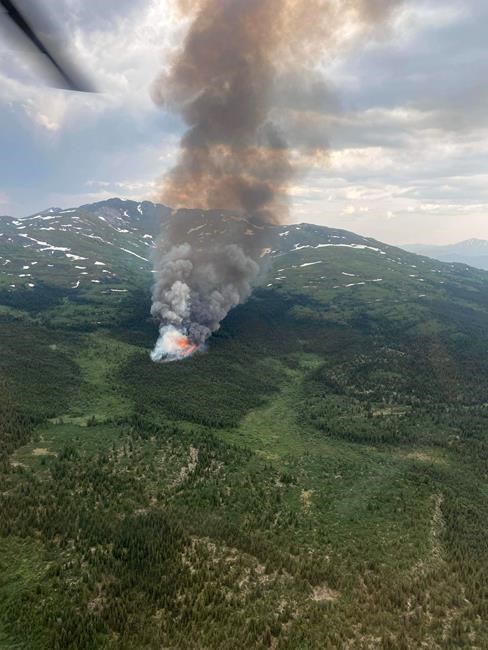
The Cap Mountain fire burning near Whitehorse, Yukon, is shown on Tuesday July 5, 2022. Wildfires are breaking out across Yukon as lightning pummels the territory and a heat wave wears on, a fire information officer says. THE CANADIAN PRESS/HO-Government of Yukon
**MANDATORY CREDIT**
Republished July 05, 2022 - 5:46 PM
Original Publication Date July 05, 2022 - 10:51 AM
WHITEHORSE - Wildfires are breaking out across Yukon as lightning pummels the territory and a heat wave wears on, a fire information officer says.
Mike Fancie of Yukon Wildland Fire Management says about 20 fires a day have been sparked beginning on the long weekend, bringing the total this year to 155 wildfires that have burned 45,000 hectares.
Fancie described the proportion of fires caused by lightning as "stupendously high" at 97 per cent, compared with about 70 per cent in a typical year with the remainder being caused by humans.
On Monday alone, there were more than 3,000 lightning strikes, 484 of which were positive strikes that carry with them increased fire danger, he said.
"The sheer volume of lightning activity and new fires over the past few days have totally obliterated that statistic," he said.
"Yukon is facing unprecedented levels of lightning-caused wildfire activity right now."
The fires come as Environment Canada issued a heat warning for much of the territory, while both fires and flooding have prompted evacuation alerts in several areas. Multiple highway closures are also impacting transportation and access to communities.
Yukon Emergency Measures Organization issued a new evacuation alert for the Silver Trail and surrounding areas Tuesday. The Ethel Lake campground was evacuated Saturday.
Of particular concern is the Crystal Lake fire in central Yukon, which has grown to 2,500 hectares and prompted an evacuation alert Sunday for Stewart Crossing about 15 kilometres away. The fire also forced the closure of part of the Klondike Highway, an important transportation link between Whitehorse, Dawson and Mayo.
Meanwhile, flood warnings have been in effect since last week for areas around Teslin Lake and Yukon River near Carmacks.
Many of the challenges are caused by a so-called Rex block weather system, which occurs when a high-pressure system sits above a low-pressure system and brings isolated thunderstorms, Fancie said.
"Why these are bad for us is that they're very stable weather patterns. So when the high-pressure ridge sits over us like this, it invariably means that we can expect this weather condition for an extended period of time and that's what's happening," he said.
Forecasters are predicting decreasing temperatures Friday and Saturday, but it's too early to count on that, he said.
Yukon has already called in extra support through mutual aid agreements from British Columbia.
There were 104 active fires Tuesday, compared with 36 on the same date last year. The total area burned by Tuesday morning was 42,979 hectares compared with 27,492 in 2021, he said.
Environment Canada also issued a heat warning Tuesday for much of the territory, urging residents to drink lots of water and seek out cool places.
Temperatures were expected to reach 28 C with nighttime lows of 13 C. The warning applied to Whitehorse, Old Crow, Dawson and other areas throughout the central, southern and western regions of the territory.
It comes after daily temperature records were set Monday in Haines Junction, Carmacks and Teslin, with heat hovering around 30 C.
— By Amy Smart in Vancouver.
This report by The Canadian Press was first published July 5, 2022.
Note to readers: This is a corrected story. A previous version said a wildfire had been named after Crystal Creek.
News from © The Canadian Press, 2022